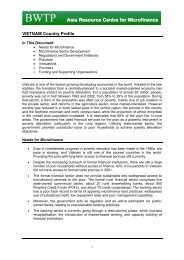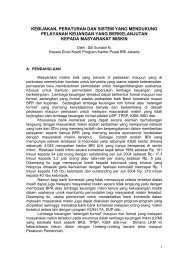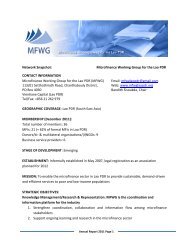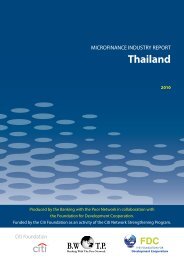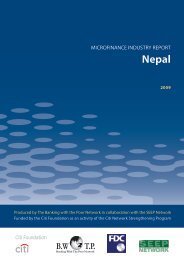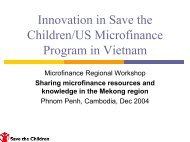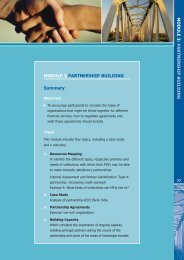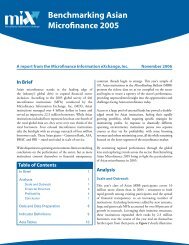microfinance industry report - Vietnam - Banking with the Poor Network
microfinance industry report - Vietnam - Banking with the Poor Network
microfinance industry report - Vietnam - Banking with the Poor Network
Create successful ePaper yourself
Turn your PDF publications into a flip-book with our unique Google optimized e-Paper software.
2. Financial Sector Overview<br />
The formal financial sector in <strong>the</strong> country is<br />
supervised by <strong>the</strong> State Bank of Viet Nam (SBV),<br />
which has branches in all 59 provinces and five<br />
municipalities and regulates and supervises banks,<br />
non-bank financial institutions, and <strong>the</strong> regulated<br />
financial cooperatives, ‘People’s Credit Funds<br />
(PCFs)’. SBV operates <strong>the</strong> Credit Information Center<br />
(CIC), functioning similarly to publicly-owned<br />
credit reference bureaux elsewhere. Supporting<br />
<strong>the</strong> regulator is <strong>the</strong> Deposit Insurance of Viet Nam<br />
(DIV), which issues deposit certificates to financial<br />
institutions and manages liquidation of failed banks<br />
and PCFs 17 .<br />
2.1 The Main Players<br />
A diverse range of banks provide wholesale and<br />
retail banking services to different market segments,<br />
namely state-owned, urban and rural joint stock,<br />
joint venture, and foreign banks. The four main stateowned<br />
commercial banks (SOCBs) dominate <strong>the</strong><br />
sector. In addition, <strong>the</strong>re are 37 joint stock commercial<br />
banks (JSCBs), which account for roughly 15% of<br />
total assets, five joint venture banks (JVBs), and 28<br />
foreign-owned banks <strong>with</strong> 39 branches. 18 From 2003<br />
to 2006, <strong>the</strong> number of banks increased from 69 to<br />
80, but <strong>the</strong> number of joint stock banks has been<br />
consolidated from 54 to 37 through mergers and<br />
acquisitions.<br />
In <strong>the</strong> initial stages of Viet Nam’s economic transition,<br />
individuals did not use <strong>the</strong> banking system to any<br />
large extent. In 1993, only 25% came from banks<br />
and o<strong>the</strong>r formal sources 19 . Until 2004, Viet Nam had<br />
ra<strong>the</strong>r shallow financial depth. However, by 2007 that<br />
depth had increased sharply, <strong>with</strong> indicators such as<br />
<strong>the</strong> credit/GDP ratio reaching 82.5%, and M2/GDP<br />
rising to 112.1% from a base of 23.8% in 1996 20 . Of<br />
this, credit to <strong>the</strong> private sector increased from 18%<br />
in 1992 to 68.6% in March 2007 21 .<br />
17 DIV: Annual Report 2005: Report on 2005 Operations and<br />
Business plan for 2006.<br />
18 State Bank of Viet Nam: 2004 Annual Report.<br />
19 1993 Viet Nam Living Standards Survey (VLSS) quoted in Viet<br />
Nam Development Report 2006: Business.<br />
20 ADBI: Managing Capital Inflows: <strong>the</strong> Case of Viet Nam, May 2008.<br />
21 IMF: Viet Nam Country Report 07/386, Statistical Appendix,<br />
December 2007.<br />
Reforms are continuing to transform (“equitize” or<br />
privatize) SOCBs to a more commercially sound<br />
footing. These SOCBs have improved operations<br />
and have streng<strong>the</strong>ned <strong>the</strong>ir balance sheets over<br />
<strong>the</strong> past five years, but an estimated average rate of<br />
8-10% non-performing loans will require significant<br />
provisioning as <strong>the</strong>y undergo equitization over <strong>the</strong><br />
coming three years. The government has already<br />
invested $635 million to recapitalize <strong>the</strong> banks and<br />
offset losses 22 (from 2001-05).<br />
With initial support from CIDA, <strong>the</strong> network of<br />
People’s Credit Funds (PCFs) were established in<br />
1993 under a Prime-ministerial decision. PCFs are<br />
community-based financial cooperatives that are<br />
owned, operated, and governed by shareholding<br />
members, modeled after <strong>the</strong> Desjardins (caisses<br />
populaires) in Quebec, Canada. PCFs are licensed<br />
under <strong>the</strong> Cooperative Law, regulated by <strong>the</strong> Law on<br />
Credit Institutions, and supervised by <strong>the</strong> SBV under<br />
<strong>the</strong> <strong>Banking</strong> Law on <strong>the</strong>ir adherence to set standards<br />
regarding financial management and member<br />
capacity. In 2007, SBV granted business licenses to 50<br />
new PCFs, and as of December 2007, <strong>the</strong>re were 982<br />
PCFs operating in 56 provinces and cities. A central<br />
apex institution, <strong>the</strong> Central People’s Credit Fund<br />
(CCF), was formed in 1995. CCF, which may soon<br />
receive a name change to <strong>the</strong> Cooperative Bank,<br />
attracts and mobilizes capital from shareholders (<strong>the</strong><br />
PCFs and <strong>the</strong> four SOCBs), donors and public deposits,<br />
serves commercial and urban customers from its 54<br />
branches and supervises/intermediates funds to <strong>the</strong><br />
local PCFs. Like VBARD and VBSP, <strong>the</strong> CCF is regulated<br />
by <strong>the</strong> Credit Institution Law and is supervised by <strong>the</strong><br />
SBV 23 .<br />
Policy lending is a key feature of Viet Nam’s financial<br />
sector. The Viet Nam Bank for Social Policy (VBSP) is<br />
mandated to serve <strong>the</strong> poor and o<strong>the</strong>r beneficiaries<br />
of government support. The Viet Nam Development<br />
Bank (VDB) serves primarily government projects,<br />
state-owned enterprises and, to a small extent (and<br />
<strong>with</strong> <strong>the</strong> support of international donors), private<br />
SMEs in <strong>the</strong> infrastructure and export sectors. Both<br />
22 World Bank: Country program Strategy 2007-2011. Some analysts<br />
believe <strong>the</strong> NPL of <strong>the</strong> SOCBs is even larger at 15-30% as per<br />
Federal Reserve Bank of San Francisco: Asia Focus, February 2008.<br />
23 World Bank: Taking stock, 2006.<br />
10 <strong>microfinance</strong> <strong>industry</strong> <strong>report</strong> - vietnam<br />
<strong>Vietnam</strong>e_Report_FOR_PRINT.indd 10<br />
27/05/2009 7:46:00 PM



